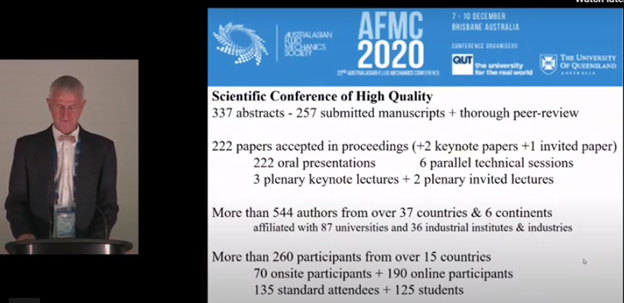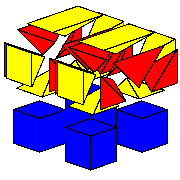CFD simulations involving 3D complex geometry have become the norm, however, this hasn’t lessened the…
20th Australasian Fluid Mechanics Conference – 5th-8th December 2016
The Australasian Fluid Mechanics Conference (AFMC) series is held biennially in December and is supported by the Australasian Fluid Mechanics Society (www.afms.org.au). The conference moves around Australia and New Zealand being hosted by Universities in the different countries. This year was the 20th conference and was hosted by the University of Western Australia (UWA), Perth.
The first AFMC was held in 1962 at UWA. That conference had 57 papers from 100 attendees. This year’s conference had 330 attendees from 16 countries with 293 papers and 7 keynote lectures. The conference has a large student attendance (~40%) and a subsequently large academic attendance (~90%). It is a good place to hear and see what fluid mechanics research is being conducted in Australian and New Zealand Universities.
With so many papers the schedule is jam packed with 4 concurrent sessions. Each presentation lasts 15 minutes and you find yourself jumping sessions to see the papers that attract your attention. The whole process feels like scientific speed dating. This year’s conference had the following sessions Aero-acoustics, Aerodynamics, Atmospheric Research, Biomedical Fluids, Boundary Layers, Combustion, Computational Fluid Dynamics, Environmental Fluids, Experimental Techniques, Fluid-structure Interaction, Gas Dynamics, Heat Transfer, Hydraulics, Hydrodynamics, Industrial Flows, Jets and Wakes, Micro/Biofluids, Multiphase Flows, Oceanography, Pipe Flows, Reacting Flows, Sports Aerodynamics, Turbulence and Wind Engineering. The number of papers in each session is influenced by the location of the conference. This conference had good representation in the Oceanography and Environmental Fluids.
At this years conference I tried to attend sessions that I normally would not attend. That meant I had to try to stay away from Multiphase sessions. That worked for the fist half of the conference, but by the end I found myself in the Multiphase sessions. What can I say, I love multiphase flows!
From the sessions that I attended I have picked three papers that I found very interesting.
- Bubble formation with a high repetition rate pulsed Tm laser by M. Mohammadzadeh, W Chan, S.R. Gonzalez-Avila, K. Liu, Z. Yan, Q.J, Wang and C.D. Ohi. This paper presented an experimental study on the formation of bubbles at the tip of a Tm laser when pulsed at a high repetition rate. Tm lasers are commonly used in medical applications such as blood clot or kidney stone ablation.
- An Immersed Boundary-Lattice Boltzmann Method for Swimming Sperms by F.B. Tian, J. Young and J.C.S. Lai. This work presented an FSI model using immersed boundary and lattice Boltzmann techniques for free swimming sperms. The videos in the presentation were very good!
- Experimental Investigation of the Motion and Shape of Flexible Objects near a Pump Inlet by A.L. Jensen, R. A. Ackl, S. Gerlach, H Sorensen, L. Rosendhal and P.U Thamsen. The topic of this talk was wet wipes and how they block sewage pumps. I bet you didn’t get that from the title. The presenter did a great job of explaining the problem and referencing some very ugly photos from Sydney Water. One of the more interesting facts was that 500 tonnes of wet-wipes are removed from Sydney’s sewage system every year (equivalent to 60 T-Rex’s). Wet-wipes account for 75% of the blockages. Whilst this was a experimental investigation the presenter showed some preliminary DEM-CFD simulations performed to model the wet-wipe as a deformable flexible object.
In addition to all the technical papers, there were 7 keynote lectures. The keynote speakers where chosen to cover a wide range of fluid mechanics topics, although you will see a theme.
- The Fluid Mechanics of Plankton – Roman Stocker, ETH Zurich. Ever wondered how plankton swim? Well no, I had not until this talk. Plankton have been shown to swim at 100 micron/s. Doesn’t sound that fast, in fact sounds very slow, however, if you put that number in body lengths per second you get ~50. Usain Bolt at top speed can travel 5.4 body lengths per second. Give that Plankton a gold Medal.
- Unsteady Aerodynamics of Sails due to Bodyweight motion – Charles Williamson, Cornell University. Ever wondered why Olympic sailors “rock and Roll” the boats? This talk covered the unsteady sail dynamics and why “rocking and rolling” can give you an advantage if done right. Enough advantage that there is a rule to make it illegal in competition, well only if you get caught.
- Internal Tide Breaking at Topography – Sonya Legg, Princeton University. Lecture discussed the breaking of internal waves in the ocean from tidal flow over topology. Breaking of internal waves drives much of the mixing in stably stratified flow and is important in climate models.
- Turbulent boundary layers developing over rough surfaces: from the laboratory to full-scale systems – Nick Hutchins, University of Melbourne. An overview of work on the problem of turbulent boundary layers developing over surface roughness was presented. The motivation was an attempt to make full-scale prediction of the extra drag on ships due to fouling of their hulls. Interesting facts, there are 90,000 large ships world wide using 5-7 million barrels of oil per day or around 7% of the worlds daily oil usage.
- Microscale Fluid-Structure Interactions: Something Old, Something New and Something Unexpected – L. Yeo, RMIT University.
- New Developments in the Understanding of Stratified Turbulence – P. Linden, Cambridge.
- Numerical Modeling Waves and Currents In the Surf Zone with Smoothed Particle Hydrodynamics – R.A. Dalrymple, Johns Hopkins University. Talk discussed the usage of SPH to model breaking waves in the surf zone. The code used for the simulations was the open source code GPUSPH.
The 21st Conference will be held at the University of Adelaide in December 2018.



